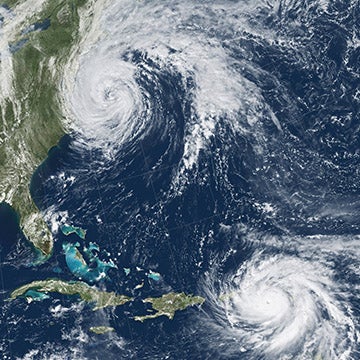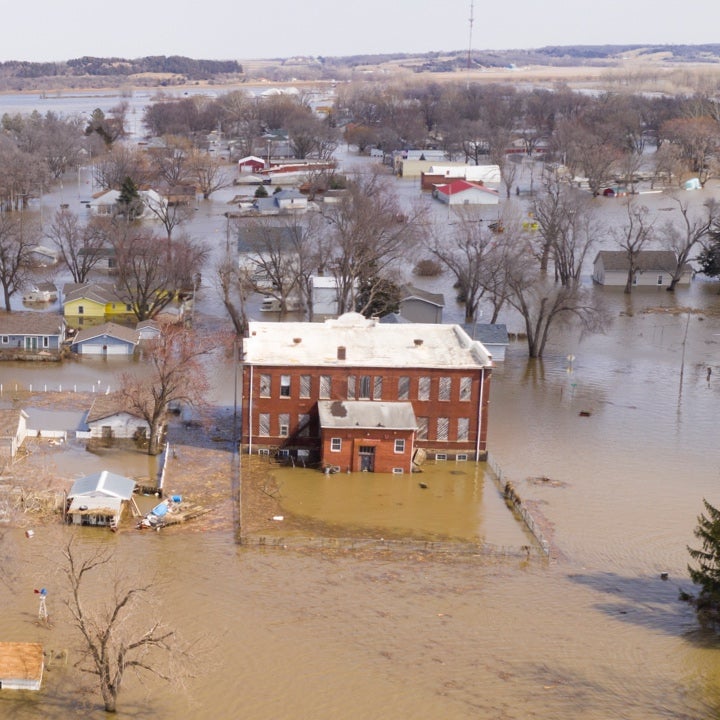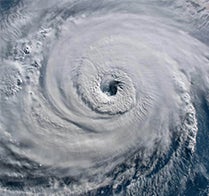
North Atlantic Hurricane
Moody’s RMS North Atlantic Hurricane Models deliver the most comprehensive view of the hurricane risk landscape.
Models, Experts and Coffee
Moody’s RMS Senior Product Manager Jeff Waters
2022 Northern Hemisphere Tropical Cyclone Outlook Report
Will 2022 be a record seventh consecutive above-normal season?
Models, Experts and Coffee
Moody’s RMS Senior Product Manager Jeff Waters
2022 Northern Hemisphere Tropical Cyclone Outlook Report
Will 2022 be a record seventh consecutive above-normal season?
Models, Experts and Coffee
Moody’s RMS Senior Product Manager Jeff Waters
Quantifying North Atlantic Hurricane Risk
Moody’s RMS North Atlantic Hurricane Models help the market gain necessary insights about the current and evolving hurricane risk landscape, informing sound underwriting, portfolio management, reinsurance, and risk transfer decisions.
Optimize Your Portfolio
Utilize the models’ basin-wide event methodology to assess key drivers of risk within and across regions to support portfolio growth and diversification strategies. The U.S. component is linked with the Moody’s RMS® U.S. Inland Flood HD Model, providing the means to develop a complete view of wind, storm surge, and tropical cyclone precipitation-induced flooding in one place.
Maximize Profitability
Grow premiums through superior risk differentiation, selection, and ratemaking decisions, enabled by the most comprehensive suite of vulnerability curves, regions, and building inventory databases on the market.
Customize Your View of Risk
Stress test model assumptions, sensitivities, and uncertainties of hurricane risk by model component, including the impacts of near- and long-term climate trends, hazard, mitigation techniques, and evolving market conditions. Assess, validate and ultimately select a view of risk that best aligns with your business needs, from underwriting through to portfolio management, reinsurance pricing and purchasing, and risk transfer decisions.
North Atlantic Hurricane Models Key Features
Developed over 25+ years, the models provide the most comprehensive solution in the market for managing tropical cyclone risk. Geographic coverage spans 40 countries, including 20+ U.S. states, Canada, Mexico, Bermuda, Central America, the Caribbean, and offshore platforms in the Gulf of Mexico.
Robust Event Set
The models are informed by a single, basin-wide stochastic event set in the Atlantic that captures the impacts of wind and storm surge for the full spectrum of landfalling, bypassing, and transitioning storms, and similar event catalogs for the East Pacific and Hawaii.
Superior Hazard Data
The models employ high-quality satellite imagery to represent local variations in wind hazard, and they integrate a hydrodynamic surge modeling framework to capture the high fidelity impacts of hurricane-induced coastal flooding in the U.S. and parts of the Caribbean.
Comprehensive Vulnerability
The North Atlantic Hurricane Models enable more effective risk differentiation and selection decisions at the local level. With over 1,750 unique vulnerability functions across a variety of building characteristics, regions, and lines of business, the models reflect the latest market practices, building codes, and building code enforcement, enabling accurate insights into vulnerability risk differentiation for underwriting and managing hurricane risk.
Unparalleled Validation and Acceptance
Gain accurate insights into potential losses to inform pricing decisions, support rating agency discussions, and determine reinsurance limit needs with confidence. The models have been extensively reviewed by clients, third-party experts, over $27 billion in detailed claims data and observations across 35+ historical events. This has supported 20+ years of FCHLPM certification in Florida and successful rate filings in 20+ states.
Feature Deep Dive
Single Basin-Wide Wind and Storm Surge Event Methodology
Hurricanes are a significant source of catastrophe risk throughout the North Atlantic Basin, including the United States, Bermuda, Canada, the Caribbean, Mexico, and Central America. The (re)insurance industry must effectively quantify, differentiate, and manage tropical cyclone risk accurately at the local level through to portfolio management, reinsurance, and capital management decisions. The Moody’s RMS® North Atlantic Hurricane Models enable these applications, simulating realistic events throughout the region using a basin-wide event methodology, capturing the impacts of wind and storm surge for a variety of landfalling, bypassing, and transitioning storms.
Over $300 Billion in Industry Loss Data Spanning More Than 25 Years
The North Atlantic Hurricane Models have been well validated by thousands of wind and storm surge observations, over US$300 billion in industry loss data, and more than US$27 billion of location-level claims and exposure data (including Hurricanes Katrina, Ike, Sandy, Harvey, Irma, and Maria, and Michael) spanning more than 25 years. In addition, the underlying model assumptions and methodologies have been extensively reviewed by numerous third-party experts. Moody’s RMS also incorporates the latest market practices and building codes for each region.
Realistic Representation of Hazard and Vulnerability
The North Atlantic Hurricane Models support effective risk differentiation and selection decisions down to the local level within and across regions. The models incorporate high-resolution satellite data (up to 15 meters), reflecting up-to-date land use and land cover information. This provides a realistic representation of local variations in wind hazard due to frictional impacts such as surface roughness, which is particularly important in urban areas with high concentrations of buildings.
The vulnerability module enables deeper and more accurate insights into risk differentiation for underwriting and managing hurricane risk. It includes unique functions representing regional vulnerability and over 1,750 combinations of primary characteristics for wind- and water-based sub-perils (storm surge for onshore risks and wave for offshore risks).
Complete and Correlated View of Hurricane Risk
Utilize the models’ basin-wide event methodology to assess key drivers of risk to support portfolio growth and diversification strategies. The U.S. component is linked with the Moody’s RMS U.S. Inland Flood HD Model, providing the means to develop a complete view of wind, storm surge, and tropical cyclone precipitation-induced flooding in one place.
Seamless Coastal to Inland Transitions
Underlying track and inland filling methodologies capture tropical cyclone characteristics throughout the full storm life cycle, reflecting the reality of how storms weaken as they lose energy over water or weaken post-landfall. This provides confidence for the market to underwrite inland hurricane risk, including the risk associated with transitioning storms.
High-Resolution Coastal Flood Risk Assessment
Moody’s RMS integrates a hydrodynamic, time-stepping storm surge solution into our hurricane models to capture the complex interactions between wind and waves throughout the life cycle of a tropical cyclone. This comprehensive model solution simulates surge buildup at sea, accounting for changes in a storm’s size and intensity prior to landfall and the dynamic flow of water around complex coastlines.
With an accurate, high-resolution representation of hurricane-driven coastal flooding, (re)insurers can manage, select, and underwrite risk with more confidence, right down to the street level, and better understand portfolio-wide tail risk driven by storm surge.
Forward-Looking Medium-Term Rates to Understand the Sensitivity of Hurricane Risk to Climate Trends
Moody’s RMS is the only modeling company to provide a five-year forward-looking view of annual hurricane landfall frequency throughout the North Atlantic Basin. Separate from the long-term historical rates, the medium-term rates consider both current and projected near-term climate trends and represent the Moody’s RMS default view of event frequency. Multiple views of event frequency allow (re)insurers to understand model sensitivities to hurricane risk across different timescales and ultimately select the view that best aligns with their view of risk.
Transparency and Detail to Understand Model Assumptions
The North Atlantic Hurricane Models come with extensive and detailed model documentation, including resources that are specific to supporting Solvency II validation. This allows Moody’s RMS to provide unprecedented transparency and support into various aspects of the models, including methodologies, validation, and change management.
Related Products

Moody’s RMS HWind
Moody’s RMS HWind provides observation-based tropical cyclone data for real-time and historical events in the Atlantic, East Pacific, and Central Pacific Basins.

U.S. Inland Flood HD Model
Identify suitable risks, implement refined underwriting guidelines, manage exposure accumulations, and design profitable growth strategies related to flood risk.

Cyclone, Hurricane, and Typhoon
Assess tropical cyclone risk to inform sound underwriting, portfolio management, and risk transfer decisions.
Resources

RMS Estimates that Insured Losses from Hurricane Isaias Wi...
NEWARK, CA – August 14, 2020 – RMS®, the world’s leading catastrophe risk solutions company, estimates that total insured losses from Hurricane Isaias will be between US$3.0 and US$5.0 billion. The estimate includes estimated losses to the National Flood Insurance Program (NFIP), which RMS expects to be between US$400m and US$700m. Hurricane Isaias insured loss estimates ranges for the U.S. and Caribbean (US$ billions): Region Insured Loss in USD B United States 3.0 ...

RMS Estimates that U.S. Insured Losses from Hurricane Hann...
NEWARK, CA – July 30, 2020 – RMS®, the world’s leading catastrophe risk solutions company, estimates that the U.S. insurance losses from Hurricane Hanna will not exceed $400 million. This estimate represents insured losses associated with wind and storm surge, including losses to the National Flood Insurance Program (NFIP). “Wind and storm surge-driven losses for Hanna are expected to be consistent with losses projected by RMS’ HWind forecast product suite prior to landfall. The storm made...

RMS Achieves Industry First With Certified Florida Commiss...
NEWARK, CA – June 24, 2019 – Today, RMS®, a leading global risk modeling and analytics firm, announced that its Version 18.1 RMS North Atlantic Hurricane Models were approved by the Florida Commission on Hurricane Loss Projection Methodology (FCHLPM) on June 13, 2019, for use in residential rate filings with the Florida Office of Insurance Regulation. The certification applies to Version 18.1 hurricane models on both RiskLink 18.1 and the forthcoming Risk Modeler 2.1 application on Risk Intel...

Version 21.0 of RMS North Atlantic Hurricane Models Certif...
NEWARK, CA – June 8, 2021 – Today, RMS®, the world’s leading catastrophe risk modeling and solutions company, announced that Version 21.0 of the RMS North Atlantic Hurricane Models was approved by the Florida Commission on Hurricane Loss Projection Methodology (FCHLPM) on June 1, 2021, for use in residential rate filings with the Florida Office of Insurance Regulation. The certification applies to Version 21.0 hurricane models available on RiskLink® 21.0 and the Risk Modeler application on the RMS open cloud...

RMS Announces New Models and RiskLink Version 21.0
NEWARK, CA – May 5, 2021 – RMS®, the world’s leading catastrophe risk modeling and solutions company, today announces new models. Speaking at the annual RMS Exceedance conference, Mohsen Rahnama Ph.D., chief risk modeling officer and executive vice president, said: “Risk is increasingly complex and connected. RMS is focused on providing the highest quality and most transparent, robust catastrophe models to the industry in this environment. With the new inland flood models and global flood hazard maps, ...

North Atlantic Hurricane Version 21: Updated Event Rates t...
With the release of the Version 21 (V21) updates to the RMS® North Atlantic Hurricane Models this summer, clients will be able to apply to their business the most current view of hurricane risk and market conditions throughout the North Atlantic Basin. This update incorporates new data and learnings from recent impactful seasons, including over US$6 billion of new claims data and insight, as well as the latest statistics on recent hurricane activity in the basin. RMS will also be the first model vendor to introd...

Atlantic Hurricane in 2020: Are We in Store for Another Re...
In the midst of the 2020 Atlantic hurricane season, with storms forming in rapid sequence, records broken early in the season and four storms already producing significant damage in the Caribbean and U.S., whether we are headed for a record-breaking year is a good question. Various forecast agencies have issued mid-season updates, which signal prospects for the remainder of the season. But what about the 2020 season to date, and how does it compare to notably active seasons of the past? In this blog, we’ll co...

RMS Estimates that Insured Losses from Hurricane Isaias Wi...
NEWARK, CA – August 14, 2020 – RMS®, the world’s leading catastrophe risk solutions company, estimates that total insured losses from Hurricane Isaias will be between US$3.0 and US$5.0 billion. The estimate includes estimated losses to the National Flood Insurance Program (NFIP), which RMS expects to be between US$400m and US$700m. Hurricane Isaias insured loss estimates ranges for the U.S. and Caribbean (US$ billions): Region Insured Loss in USD B United States 3.0 ...

RMS Estimates that U.S. Insured Losses from Hurricane Hann...
NEWARK, CA – July 30, 2020 – RMS®, the world’s leading catastrophe risk solutions company, estimates that the U.S. insurance losses from Hurricane Hanna will not exceed $400 million. This estimate represents insured losses associated with wind and storm surge, including losses to the National Flood Insurance Program (NFIP). “Wind and storm surge-driven losses for Hanna are expected to be consistent with losses projected by RMS’ HWind forecast product suite prior to landfall. The storm made...

RMS Achieves Industry First With Certified Florida Commiss...
NEWARK, CA – June 24, 2019 – Today, RMS®, a leading global risk modeling and analytics firm, announced that its Version 18.1 RMS North Atlantic Hurricane Models were approved by the Florida Commission on Hurricane Loss Projection Methodology (FCHLPM) on June 13, 2019, for use in residential rate filings with the Florida Office of Insurance Regulation. The certification applies to Version 18.1 hurricane models on both RiskLink 18.1 and the forthcoming Risk Modeler 2.1 application on Risk Intel...

Version 21.0 of RMS North Atlantic Hurricane Models Certif...
NEWARK, CA – June 8, 2021 – Today, RMS®, the world’s leading catastrophe risk modeling and solutions company, announced that Version 21.0 of the RMS North Atlantic Hurricane Models was approved by the Florida Commission on Hurricane Loss Projection Methodology (FCHLPM) on June 1, 2021, for use in residential rate filings with the Florida Office of Insurance Regulation. The certification applies to Version 21.0 hurricane models available on RiskLink® 21.0 and the Risk Modeler application on the RMS open cloud...

RMS Announces New Models and RiskLink Version 21.0
NEWARK, CA – May 5, 2021 – RMS®, the world’s leading catastrophe risk modeling and solutions company, today announces new models. Speaking at the annual RMS Exceedance conference, Mohsen Rahnama Ph.D., chief risk modeling officer and executive vice president, said: “Risk is increasingly complex and connected. RMS is focused on providing the highest quality and most transparent, robust catastrophe models to the industry in this environment. With the new inland flood models and global flood hazard maps, ...

North Atlantic Hurricane Version 21: Updated Event Rates t...
With the release of the Version 21 (V21) updates to the RMS® North Atlantic Hurricane Models this summer, clients will be able to apply to their business the most current view of hurricane risk and market conditions throughout the North Atlantic Basin. This update incorporates new data and learnings from recent impactful seasons, including over US$6 billion of new claims data and insight, as well as the latest statistics on recent hurricane activity in the basin. RMS will also be the first model vendor to introd...

Atlantic Hurricane in 2020: Are We in Store for Another Re...
In the midst of the 2020 Atlantic hurricane season, with storms forming in rapid sequence, records broken early in the season and four storms already producing significant damage in the Caribbean and U.S., whether we are headed for a record-breaking year is a good question. Various forecast agencies have issued mid-season updates, which signal prospects for the remainder of the season. But what about the 2020 season to date, and how does it compare to notably active seasons of the past? In this blog, we’ll co...

RMS Estimates that Insured Losses from Hurricane Isaias Wi...
NEWARK, CA – August 14, 2020 – RMS®, the world’s leading catastrophe risk solutions company, estimates that total insured losses from Hurricane Isaias will be between US$3.0 and US$5.0 billion. The estimate includes estimated losses to the National Flood Insurance Program (NFIP), which RMS expects to be between US$400m and US$700m. Hurricane Isaias insured loss estimates ranges for the U.S. and Caribbean (US$ billions): Region Insured Loss in USD B United States 3.0 ...

RMS Estimates that U.S. Insured Losses from Hurricane Hann...
NEWARK, CA – July 30, 2020 – RMS®, the world’s leading catastrophe risk solutions company, estimates that the U.S. insurance losses from Hurricane Hanna will not exceed $400 million. This estimate represents insured losses associated with wind and storm surge, including losses to the National Flood Insurance Program (NFIP). “Wind and storm surge-driven losses for Hanna are expected to be consistent with losses projected by RMS’ HWind forecast product suite prior to landfall. The storm made...

RMS Achieves Industry First With Certified Florida Commiss...
NEWARK, CA – June 24, 2019 – Today, RMS®, a leading global risk modeling and analytics firm, announced that its Version 18.1 RMS North Atlantic Hurricane Models were approved by the Florida Commission on Hurricane Loss Projection Methodology (FCHLPM) on June 13, 2019, for use in residential rate filings with the Florida Office of Insurance Regulation. The certification applies to Version 18.1 hurricane models on both RiskLink 18.1 and the forthcoming Risk Modeler 2.1 application on Risk Intel...

Need Help Managing Hurricane Risk?




